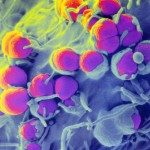Link to Pubmed [PMID] – 16171390
Biochemistry 2005 Sep;44(38):12759-66
The Bordetella adenylate cyclase toxin-hemolysin (CyaA, ACT, or AC-Hly) forms cation-selective membrane channels and delivers into the cytosol of target cells an adenylate cyclase domain (AC) that catalyzes uncontrolled conversion of cellular ATP to cAMP. Both toxin activities were previously shown to depend on post-translational activation of proCyaA to CyaA by covalent palmitoylation of the internal Lys983 residue (K983). CyaA, however, harbors a second RTX acylation site at residue Lys860 (K860), and the role of K860 acylation in toxin activity is unclear. We produced in E. coli the CyaA-K860R and CyaA-K983R toxin variants having the Lys860 and Lys983 acylation sites individually ablated by arginine substitutions. When examined for capacity to form membrane channels and to penetrate sheep erythrocytes, the CyaA-K860R acylated on Lys983 was about 1 order of magnitude more active than CyaA-K983R acylated on Lys860, although, in comparison to intact CyaA, both monoacylated constructs exhibited markedly reduced activities in erythrocytes. Channels formed in lipid bilayers by CyaA-K983R were importantly less selective for cations than channels formed by CyaA-K860R, intact CyaA, or proCyaA, showing that, independent of its acylation status, the Lys983 residue may play a role in toxin structures that determine the distribution of charged residues at the entry or inside of the CyaA channel. While necessary for activity on erythrocytes, acylation of Lys983 was also sufficient for the full activity of CyaA on CD11b+ J774A.1 monocytes. In turn, acylation of Lys860 alone did not permit toxin activity on erythrocytes, while it fully supported the high-affinity binding of CyaA-K983R to the toxin receptor CD11b/CD18 and conferred on CyaA-K983R a reduced but substantial capacity to penetrate and kill the CD11b+ cells. This is the first evidence that acylation of Lys860 may play a role in the biological activity of CyaA, even if redundant to the acylation of Lys983.

